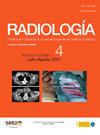Factores de riesgo clínicos y radiológicos para recurrencia de fibrilación auricular tras la ablación de venas pulmonares
IF 1.1
Q3 RADIOLOGY, NUCLEAR MEDICINE & MEDICAL IMAGING
引用次数: 0
Abstract
Background and objective
Atrial fibrillation (AF) is the most common cardiac arrhythmia worldwide. Previous studies have described that certain clinical characteristics such as age, obesity, the type of AF, and imaging-based factors, such as left atrial (LA) volume, mean density (calculated as the average of Hounsfield Units values in a certain region of interest), and volume of cardiac adipose tissue, may increase the risk of recurrence following pulmonary vein ablation. However, there have been contradictory results regarding radiological variables in previous studies. The objective of this study was to evaluate these clinical and radiological risk factors obtained from computed tomography (CT) studies.
Materials and methods
This retrospective case-control study included all patients with AF who underwent initial radiofrequency or cryoablation of pulmonary veins after undergoing contrast-enhanced CT between 2017 and 2021. Clinical variables such as age, gender, comorbidities, medications used after ablation, type of AF, and radiological variables obtained from volumetric segmentation of CT studies were collected. Radiological variables included LA volume, mean density, and volume of epicardial, periatrial, and interatrial adipose tissue. The occurrence or absence of AF recurrence within 12 months after ablation was also recorded. These variables were subjected to univariate and multivariate analysis to evaluate the risk of recurrence.
Results
Among the total number of included patients, 40 had paroxysmal AF and 12 had persistent AF. During the follow-up period, 12 patients (23.1%) experienced AF recurrence, while 40 patients (76.9%) remained in sinus rhythm. There were statistically significant differences in LA volume based on the type of AF, with higher volumes observed in patients with persistent AF (119.16 ± 32.38 cc) compared to the rest (90.99 ± 28.34 cc). Regarding the differences between patients with and without recurrence after ablation, only LA volume (P < .05) and periatrial adipose tissue volume (P < .01) were significantly higher in patients with recurrence.
Conclusion
The type of atrial fibrillation, increased left atrial volume, and increased periatrial adipose tissue volume are risk factors for recurrence in patients with atrial fibrillation undergoing pulmonary vein ablation using cryoablation or radiofrequency.
肺静脉切除后耳部纤颤复发的临床和放射危险因素
背景与目的房颤(AF)是世界范围内最常见的心律失常。先前的研究已经描述了某些临床特征,如年龄、肥胖、房颤类型,以及基于影像学的因素,如左房(LA)体积、平均密度(以某一感兴趣区域的霍斯菲尔德单位值的平均值计算)和心脏脂肪组织体积,可能会增加肺静脉消融后复发的风险。然而,在以往的研究中,关于放射变量的结果是相互矛盾的。本研究的目的是评估从计算机断层扫描(CT)研究中获得的这些临床和放射学危险因素。材料和方法本回顾性病例对照研究纳入了2017年至2021年间接受增强CT扫描后接受肺静脉射频或冷冻消融治疗的所有房颤患者。收集临床变量,如年龄、性别、合并症、消融后使用的药物、房颤类型以及CT体积分割研究获得的放射学变量。放射学变量包括LA体积、平均密度以及心外膜、房周和房间脂肪组织的体积。同时记录消融后12个月内房颤复发的发生或消失情况。对这些变量进行单因素和多因素分析,以评估复发风险。结果本组患者中阵发性房颤40例,持续性房颤12例,随访期间房颤复发12例(23.1%),窦性心律保持40例(76.9%)。不同房颤类型的LA容积差异有统计学意义,持续性房颤患者的LA容积(119.16±32.38 cc)高于其他患者(90.99±28.34 cc)。关于消融后有无复发患者的差异,仅LA体积(P <;0.05)和心房周围脂肪组织体积(P <;.01),复发率明显增高。结论房颤类型、左房容积增大、房周脂肪组织体积增大是冷冻或射频肺静脉消融房颤患者复发的危险因素。
本文章由计算机程序翻译,如有差异,请以英文原文为准。
求助全文
约1分钟内获得全文
求助全文
来源期刊

RADIOLOGIA
RADIOLOGY, NUCLEAR MEDICINE & MEDICAL IMAGING-
CiteScore
1.60
自引率
7.70%
发文量
105
审稿时长
52 days
期刊介绍:
La mejor revista para conocer de primera mano los originales más relevantes en la especialidad y las revisiones, casos y notas clínicas de mayor interés profesional. Además es la Publicación Oficial de la Sociedad Española de Radiología Médica.
 求助内容:
求助内容: 应助结果提醒方式:
应助结果提醒方式:


